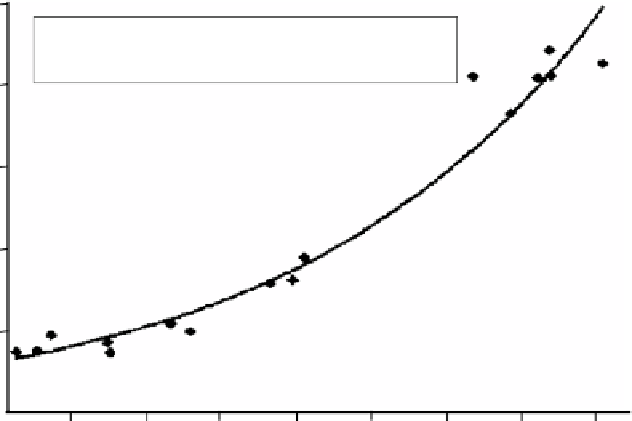Agriculture Reference
In-Depth Information
500
polarization of the L-bands (23 cm wavelength) :
HH = horizontal transmit to target as well as receive
VV = vertical transmit to target as well as receive
400
300
200
r
2
= 0.94
0.4665X
100
y = 712.92 e
incidence angles 23°, 27° and 30°
0
0
0.5
1.0
1.5
2.0
2.5
3.0
3.5
4.0
quotient of radar L-band HH divided by radar L-band VV (dimensionless)
Fig. 6.20
Estimating the biomass of winter barley via a quotient of like-polarized radar waves and
remote sensing from satellite (From Kühbauch and Hawlitschka
2003
, altered)
•
Recording of the height and the biomass of vegetation is possible. Non-polarized
radiation might just provide rough estimates, whereas fully exploiting the poten-
tials of polarization allows precise indications (Fig.
6.20
).
•
Leaf-area-index can be indicated if the wavelength fits to the crop. With maize,
the
l
l-band (23 cm wavelength) provided good results whereas the X-band
(3.1 cm wavelength) completely failed (Jiao et al.
2010
).
•
Crop classification for wide area monitoring and mapping is possible. This is the
main present application. Supplementing the indications based on radar by
estimations that rely on visible and infrared radiation is not necessary.
Modern radar satellites can provide the spatial resolution that is needed for
site-speciic farming. The resolutions that can be obtained go down to a few m.
And regarding the temporal resolution, the prospects too are good because the
number of satellites is increasing. This means that temporal limitations for
receiving information about crop properties via remote microwave sensing prob-
ably will not exist any more in the future. The information can be supplied day
and night irrespective of clouds and haze. Only heavy precipitation might pre-
vent the use. Because of the almost unlimited temporal possibilities, proximal
sensing of crop properties via radar does not seem attractive. At least not as long
as proximal sensing needs the attention of a driver and therefore is difficult to
repeat any time.

